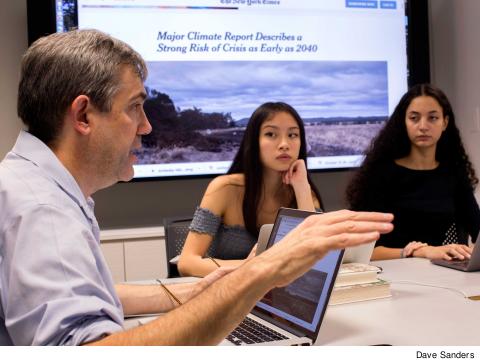Co-author of a key United Nations report
 |
A report by the United Nations’ Intergovernmental Panel on Climate Change released in October unleashed a flurry of press responses, with many environmental activists from around the world declaring it a wake-up call and an urgent plea – as if made from the planet itself – for serious and drastic action to fend off the devastating effects of climate change. Ashley Dawson, a professor of English at College of Staten Island and the author of Extreme Cities: The Peril and Promise of Urban Life in the Age of Climate Change, called the study “pretty shattering.”
“The authors found that if greenhouse gas emissions continue at the current rate, the atmosphere will warm up by as much as 2.7 degrees Fahrenheit (1.5 degrees Celsius) above preindustrial levels by 2040, inundating coastlines and intensifying droughts and poverty,” the New York Times reported.
One of the dozens of scholars from around the world who authored the report is William Solecki, a professor of geography at Hunter College and the founding director of the CUNY Institute for Sustainable Cities.
A UNION CAUSE
The PSC has long been active in the climate justice movement, and members involved in the environmental justice committee were eager to know, after the study’s release, what the panel thought people should do in response. The report said that averting climate catastrophe would require an investment of $54 trillion to avoid 2.7 degrees (Celsius) of warming, and offered the idea of implementing carbon dioxide emissions taxes as high as $27,000 per ton.
Solecki, in an interview with Clarion, noted that the report was not meant to be prescriptive, but rather a basis of inquiry for governments to use as means of assessing the threat of climate change. Of course, the issue of “what do we do now?” has been on a lot of people’s minds.
“The assessment of the literature is that there is a variety of alternative energy sources and that all of them need to be examined,” he said. “There is global variation in terms of which ones are the most effective and meaningful. Nuclear power is complicated, for all the reasons that we know, and it was evaluated in the assessment, as well as other forms of alternative energy.”
LOOK TO CITIES
A scholar focusing on cities, Solecki said it was important to look at how urban centers around the world have historically tackled environmental problems and made transformative changes – coastal cities, for example, have researched resiliency plans in response to the threat of rising sea levels and serious hurricanes.
Many members asked: What can we, as academics, even in the social sciences and the humanities, do to mitigate the damage? Solecki responded that contributions from the liberal arts were vital in the fight for climate justice. After all, much of the work isn’t just scientific study about the environment, but about winning hearts and minds to make the kinds of tough policy changes necessary to face the threat.
“The report looked at six dimensions of feasibility, and the most challenging things were social issues, social values and finances, the capacity of institutions to change,” he said. “Absolutely, there is a lot of work that the physical sciences need to do, but the most challenging questions are going to be embedded in the social sciences.”
SOCIETAL ISSUE
He added, “And the humanities will play a significant role in providing people an opportunity to understand and reflect on what these changes might mean. We’re starting to see a real flowering of climate literature and a lot of art, people are developing plays. Philosophy and ethics are going to be central to this discussion.”
The gravity of the report is sobering enough, but in the chaotic final days of preparing the report as well as responding to the constant queries about it since its release, Solecki has remained calm and focused on the facts.
“You get buried under all the comments and making sure all the comments are addressed, you don’t really think about it too much,” he said. “It has been a whirlwind from start to finish.”

